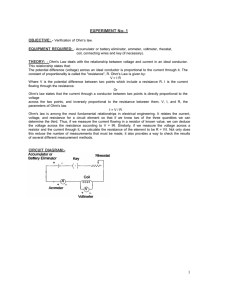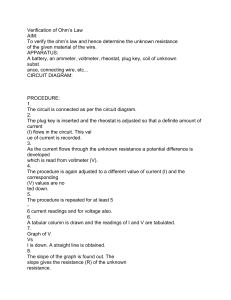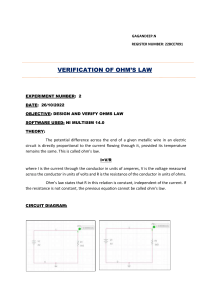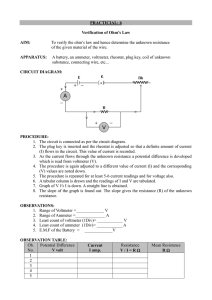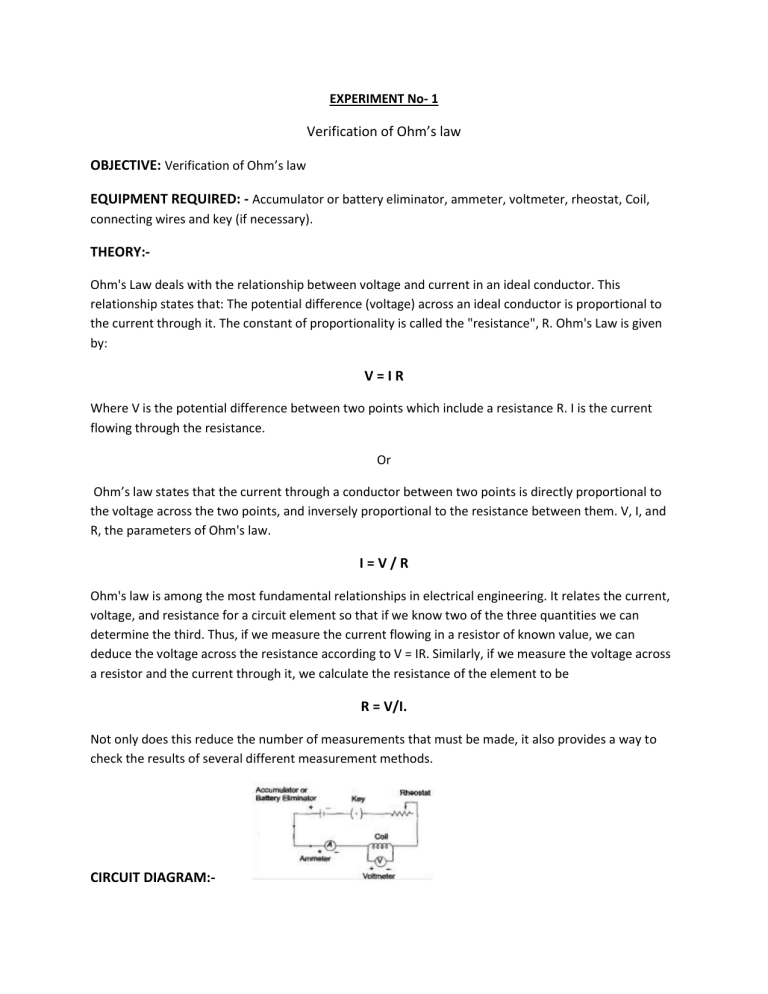
EXPERIMENT No- 1 Verification of Ohm’s law OBJECTIVE: Verification of Ohm’s law EQUIPMENT REQUIRED: - Accumulator or battery eliminator, ammeter, voltmeter, rheostat, Coil, connecting wires and key (if necessary). THEORY:Ohm's Law deals with the relationship between voltage and current in an ideal conductor. This relationship states that: The potential difference (voltage) across an ideal conductor is proportional to the current through it. The constant of proportionality is called the "resistance", R. Ohm's Law is given by: V=IR Where V is the potential difference between two points which include a resistance R. I is the current flowing through the resistance. Or Ohm’s law states that the current through a conductor between two points is directly proportional to the voltage across the two points, and inversely proportional to the resistance between them. V, I, and R, the parameters of Ohm's law. I=V/R Ohm's law is among the most fundamental relationships in electrical engineering. It relates the current, voltage, and resistance for a circuit element so that if we know two of the three quantities we can determine the third. Thus, if we measure the current flowing in a resistor of known value, we can deduce the voltage across the resistance according to V = IR. Similarly, if we measure the voltage across a resistor and the current through it, we calculate the resistance of the element to be R = V/I. Not only does this reduce the number of measurements that must be made, it also provides a way to check the results of several different measurement methods. CIRCUIT DIAGRAM:- PROCEDURE:- Connect the battery eliminator, ammeter, the given coil, rheostat and key (if necessary) in series. The voltmeter is connected in parallel connection across the given coil. The circuit is closed. Now the rheostat is adjusted so that a constant current flows through the coil. Note down the ammeter reading I and the corresponding potential difference across the coil in the voltmeter as V. Use the formula to calculate the resistance of the coil. The experiment is repeated for different values of current and the corresponding potential difference is noted. Calculate the value in each trial. These values will be found to be a constant. Thus verifying Ohm's law. OBSERVATION TABLE:TRAIL NO AMMETER READING I ( AMPERE) VOLT METER READING V (VOLT) RESISTANCE OF COIL R=V/R (OHM) 1. 2. 3. 4. 5. RESULT:By observing the observation table, it is proved that the ratio of potential difference and current is constant. Thus, potential difference at the ends of the conductor is directly proportional to the current flowing through it. Thus, ohm’s law is verified by this experiment. PRECAUTIONS: 1. All the connection should be tight. 2. Ammeter is always connected in series in the circuit while voltmeter is parallel to the conductor. 3. The electrical current should not flow the circuit for long time, otherwise its temperature will increase and the result will be affected. 4. Maximum reading of voltmeter should be greater than the electromotive force of the cell. 5. It should be care that the values of the components of the circuit is does not exceed to their ratings (maximum value). 6. Before the circuit connection it should be check out working condition of all the components.

